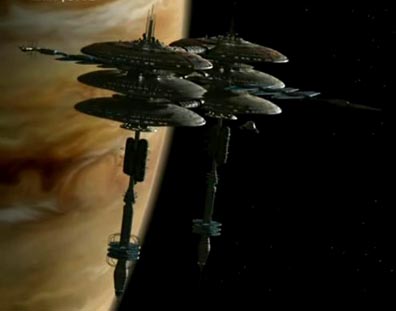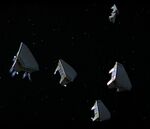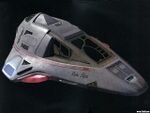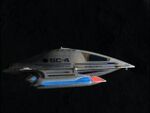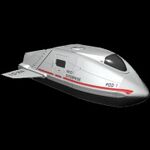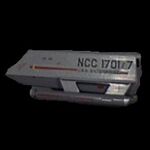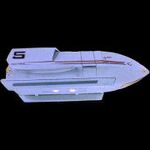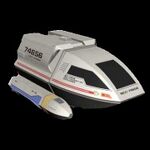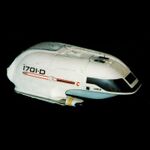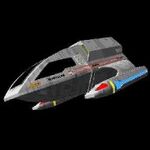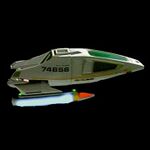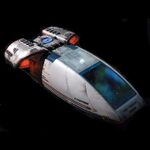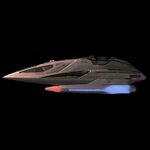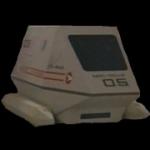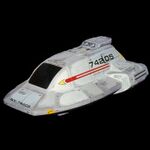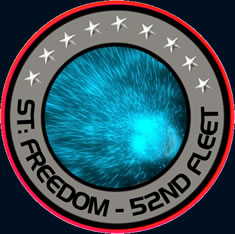Federation Auxiliary Craft
In starship classification,auxiliary craft are typically attached to a starship or a starbase. Most are short-range starships, possessing only impulse drive or a limited warp capability. Utilization of auxiliary craftis common for most spacefaring civilizations, especially for situations where the transporter cannot be used for landings, or where such technology does not yet exist.
Auxiliary craft range in size from the larger, longer-range, and more versatile type of shuttle, known as a runabout, to the small and short-range type of shuttle, known as a shuttlecraft.
Most Starfleet auxiliary craft from the 23rd century and onward had warp nacelles indicating warp capability.
Federation Auxiliary Craft and Technical Readouts
Cargo Shuttlecraft
Type-9A Cargo Shuttlecraft
Short of a full-fledged transport ship, the Type-9A Cargo Shuttle is the primary shuttle of choice for cargo runs at major Starfleet facilities. Originally developed by the ASDB team stationed at Utopia Planitia, the 9A served as cargo vessel that carried components from the surface of Mars to the facilities in orbit. While able to travel at warp velocities, the 9A is somewhat slow at sub-light speeds, especially when carrying large amounts of cargo. The front of the shuttle is divided by a wall with a closable hatch, allowing for the aft area to be opened to the vacuum of space. The 9A also has the ability to carry one Type-M1 Sphinx Workpod in the aft area. A medium-range Transporter and atmospheric flight capabilities allow it to easily complete its tasks. While rarely seen stationed aboard all but the largest starships, the Type-9A is a common site at any large Starfleet facility.
Marine Transports
Stallion Class Marine Drop-Shuttle
The Stallion Transport shuttle is a large cargo shuttle, with Danube level capacity. It is designed to be able to be used in several roles with multiple mission modules. It ihas displayed ruggedness to withstand longer periods of time between maintenance overhauls, as well as battlefield conditions. It's central interchangeable module allows for exceptional flexibility for a wide variety of mission requirements. This is the Primary Transport used by the Starfleet Marines.
Trojan Class Marine Drop-Shuttle
The Trojan Class marine Drop ship is one of the most heavily armed auxiliary craft in active service. The ship is designed to withstand blistering enemy fire during combat actions. The vessel's primary purpose is to transport Starfleet marines into active combat zones. This could include boarding operations as well as planetary landings. The vessel is well designed and boasts a hardy and well-earned reputation for withstanding the most inhospitable landing zones. These vessels were in operation during the Federation Civil war where they were quickly proven to be exceptionally reliable.
Mission Specialized Craft
Waverider Craft
An auxiliary craft for Nova Class Survey Vessels, the WaveRider-Type atmospheric shuttlecraft is designed to facilitate close quarters examination and survey of planetary bodies by science personnel aboard the ship.
At just over 20 meters in length, the vessel is small enough to be carried by the Nova Class but large enough to be useful. Intended to work in atmosphere, the small craft is high fuel efficient at Mach-5 and above, making use of the conventional propulsion with back up impulse and RCS thrusters for maneuvering in space.
Work Bee
The Work Bee is a capable stand-alone craft used for inspection of spaceborne hardware, repairs, assembly, and other activates requiring remote manipulators. The fully pressurized craft has changed little in design during the past 150 years, although periodic updates to the internal systems are done routinely. Onboard fuel cells and microfusion generators can keep the craft operational for 76.4 hours, and the life-support systems can provide breathable air, drinking water and cooling for the pilot for as long as fifteen hours. If the pilot is wearing a pressure suit or SEWG, the craft allows for the operator to exit while conducting operations. Entrance and exit is provided by the forward window, which lifts vertically to allow the pilot to come and go.
Type-M1 Sphinx Workpod
Along with the Work Bee, the various Sphinx Workpod types are a common site in any large Federation shipbuilding facility. Intended never to be far from its parent facility, the Workpod was designed to allow greater user hands-on control of the various functions involved with day-to-day construction and repair. With more tools then the Work Bee, the Sphinx M1A and M2A are used primarily to manipulate spaceborne hardware during construction. The Sphinx MT3D is a third variant of this robust design, and can be used for towing objects to and from the construction site. Furthermore, a group of MT3D units can work together to tow larger objects into place, including most starship classes, when large tractor emitters are not an option. All three variants utilize the same basic systems, and are small enough to fit inside of a Type-9A Cargo Shuttlecraft. All variants of the Sphinx Workpod are commonly found at Federation Fleet Yards and Starbases, as well as on larger Starfleet vessels.
Escape Pod
In starship classification, an escape pod or life pod or evacuation pod is a small capsule found aboard most starships that are used in the event that the ship is damaged and pending destruction. Starfleet vessels have enough escape pods to evacuate the entire crew and any non-Starfleet personnel.
Mission Scout
The Federation mission scoutship was a type of Federation auxiliary craft in operation during the late 24th century.
The scout was a single-pilot starship with a forward mounted cockpit separated from the rest of the vessel. It was slightly larger in size than the Enterprise-E shuttlecraft, and carried dual-mounted phaser banks and photon torpedoes. The vessel is accessible through its docking hatch on the ventral hull. (Star Trek: Insurrection)
Travel Pod
A travel pod was a small Federation shuttlepod predominately used during the 23rd century by facilities like the San Francisco Fleet Yards to transfer personnel to drydocks or spaceships. These vessels have a flight crew that can include 1 pilot and up to 7 passengers.
Captain's Yacht
The Sovereign Class captain's yacht was a large auxiliary craft which normally docked on the ventral side of the saucer section, opposite the bridge, and immediately below the saucer torpedo launcher. When connected to the Sovereign class, only the bottom side of the yacht was exposed to space; the top of the craft was concealed by the ship and the warp nacelles were folded against the hull. Upon launch, the Yacht's Nacelles folded downward and the entire ship dropped away from the mothership.
Personnel Shuttlecraft
Aeroshuttle
The Aeroshuttle (or AeroWing) was a large shuttle attached to the underside of the primary hull of the Intrepid-class starships. When detached, the Aeroshuttle was capable of atmospheric flight as well as interstellar travel at speeds up to warp 3. The Aeroshuttle cockpit is designed for a crew of four.
Although the Aeroshuttle spaceframe and basic systems were completed by Stardate 46875.3, final outfitting of mission-specific hardware was delayed until simulations and flight testing with the USS Intrepid could be completed.
Argo Shuttle
The Argo shuttle is the latest and most advanced design of shuttlecraft thus far.It is 20 meters in length and appears to be warp capable. it is used on Sovereign-class starships
The Argo was designed with recessed warp nacelles and fold-down wings. The ship, equipped with retractable wings allow the craft to easily land on a variety of planet surfaces, the also assist in atmospheric maneuverability. In addition to these features the vessel is equipped with a large aft cargo door.
Delta Flyer
The Delta Flyer was a unique Starfleet shuttlecraft constructed by the crew of the USS Voyager in the Delta Quadrant in 2375. The vessel was designed to handle environments that would be too hazardous for a standard shuttlecraft, the crew having acknowledged that standard shuttles were of little use in the increasingly hostile and unexplored Delta Quadrant. The vessel was a blend of Starfleet and Borg technology, designed in collaboration between B'Elanna Torres, Tom Paris, Tuvok, Harry Kim and Seven of Nine. It featured an ultra-aerodynamic tetraburnium alloy hull, retractable warp nacelles, parametallic hull plating, unimatrix shielding, and a Borg-inspired weapon system, including photonic missiles, most of which were Paris' conceptions. For aesthetic reasons, Paris designed the flight controls to resemble those of 20th century aircraft. But to Paris' disappointment, the addition of dynametric tailfins was denied by Tuvok. (VOY: "Extreme Risk")
Janeway's Shuttle (SC-4)
In 2404 of an alternate timeline, this shuttlecraft was Admiral Kathryn Janeway's personal vessel. The shuttle had been equipped with a stealth generator, ablative generator-deployed hull armor, transphasic torpedoes, and a neural interface and synaptic transceiver system.
Type-0 Personnel Shuttlecraft
In the mid-22nd century, Type 0 Shuttles were able to seat a pilot and six passengers, although conditions aboard the vehicles were cramped. Each Type 0 Shuttle had an entrance on the roof, one at either side and a large entrance at the back. Seating arrangements consisted of a swiveling chair for the pilot, two similar chairs behind the pilot, and at the rear of the craft, two upholstered benches which doubled as bunks when necessary, and had lift-up seats for access to storage compartments.
Type-1 Personnel Shuttlecraft
The Type 1 shuttlecraft was the standard issue Starfleet shuttlecraft during the mid-23rd century. During the mid-2260s, Type 1 shuttles were based at starbases and aboard Constitution-class starships, which were standard equipped with four shuttles of this class, along with other shuttle classes. The Type 1 shuttlecraft would remain in service until the early 2270s, where they were still being deployed to and from the San Francisco air tram station.
Type-3 Personnel Shuttlecraft
The type 3 shuttlecraft was a short-range Starfleet auxiliary vehicle carried aboard Federation starships and space stations during the 24th century. The type 3 shuttlecraft was introduced sometime prior to 2364. They are part of the standard shuttlecraft loadout aboard Galaxy class, Intrepid-class , and Nebula-class starships. Space stations such as Relay Station 47 also support type 3 shuttlecraft
Type-6 Personnel Shuttlecraft
The Type-6 Personnel Shuttlecraft is currently in widespread use throughout Starfleet, and is only recently being replaced by the slightly newer Type-8 Shuttle of similar design. The Uprated version of this vessel is considered to be the ideal choice for short-range interplanetary travel, and its large size makes it suitable to transport personnel and cargo over these distances.
A short-range transporter is installed onboard, allowing for easy beam out of cargo and crew to and from their destination. Atmospheric flight capabilities allow for this shuttle type to land on planetary surfaces. Ships of this type are currently in use aboard virtually every medium to large sized starship class, as well as aboard stations and Starbases.
Type-7 Personnel Shuttlecraft
With the borders of the Federation ever expanding as Starfleet reached the latter half of the 24th Century, the ASDB realized that there was sufficient need for a shuttlecraft capable of making the week-long journeys between planets and stations at low warp. The Type-7 was the first step in this direction, and is equipped for short-range warp travel. To offer comfort to its occupants, the shuttle contains a standard replicator system and sleeping compartments. The forward and aft compartments are separated by a small, informal living area that has a workstation and table. The aft area is normally equipped with a bunk area, but can easily be converted to allow for increased cargo capabilities. A medium-range transporter and atmospheric flight capabilities allow for the Type-7 to service starbases, starships and stations. Ships of this type are currently in use aboard most medium to large sized starship classes, as well as aboard stations and Starbases.
Type-8 Personnel Shuttlecraft
Based upon the frame of the Type-6, the Type-8 Shuttlecraft is the most capable follow-up in the realm of personnel shuttles. Only slightly larger, the Type-8 is equipped with a medium-range transporter and has the ability to travel within a planet’s atmosphere. With a large cargo area that can also seat six passengers, the shuttle is a capable transport craft. Slowly replacing its elder parent craft, the Type-8 is now seeing rapid deployment on all medium to large starships, as well as to Starbases and stations throughout the Federation.
Type-9 Personnel Shuttlecraft
The Type-9 Personnel Shuttle is a long-range craft capable of traveling at high warp for extended periods of time due to new advances in variable geometry warp physics. Making its debut just before the launch of the Intrepid-class, this shuttle type is ideal for scouting and recon missions, but is well suited to perform many multi-mission tasks. Equipped with powerful Type-VI phaser emitters, the shuttle is designed to hold its own ground for a longer period of time. Comfortable seating for four and moderate cargo space is still achieved without sacrificing speed and maneuverability. As is standard by the 2360’s, the shuttle is equipped with a medium-range transporter and is capable of traveling through a planet’s atmosphere. With its ability to travel at high-warp speeds, the Type-9 has been equipped with a more pronounced deflector dish that houses a compact long-range sensor that further helps it in its role as a scout. The Type-9 is now being deployed throughout the fleet and is especially aiding deep-space exploratory ships with its impressive abilities.
Type-10 Personnel Shuttlecraft
Developed specifically for the Defiant-class starship project, the Type-10 Personnel Shuttle is the largest departure from the traditional role of an auxiliary craft that Starfleet has made in the past century. Short of a dedicated fighter craft, the Type-10 is one of the most powerful auxiliary ships, with only the bulkier Type-11 being more heavily equipped. Nonetheless, the shuttle sports increased hull armor and the addition of micro-torpedo launchers, as well as a suite of tactical jamming devices. A larger warp coil assembly, as well as torpedo stores, makes the Type-10 much more heavier then other shuttles. Elements from the Defiant-class project that were incorporated into the shuttle include armored bussard collectors, as well as a complex plasma venting system for use during possible warp core breech situations. This bulky craft is equipped with a powerful navigation deflector that allows it to travel at high-warp, and a complex sensor system makes this shuttle suitable for reconnaissance work. Able to hold its own in battle situations, the Type-10 is seeing limited deployment on Defiant-class starships, as well as border patrol vessels and combat-ready ships.
Type-11 Personnel Shuttlecraft
With an ultimate goal towards creating a useful all-purpose shuttlecraft, the designers of the Type-11 Personnel Shuttle set out to create a craft that was equipped with all the systems of a starship within the shell of a relatively small shuttle. Allocation of the larger Danube-class runabout to starships in the field proved too costly, and with the expressed need by the Sovereign-class development team for a capable shuttle, the Type-11 was born. Its overall frame and components are a meshing of lessons learned in both the Type-9 and Danube-class vessels. Impressive shielding, several phaser emitters, micro-torpedo launchers and a capable warp propulsion system makes this shuttle capable of performing a multitude of tasks. Both the ventral and dorsal areas of the shuttle feature a new magnaclamp docking port that is capable of linking up to other ships similarly equipped. A two-person transporter and a large aft compartment with a replicator adds to the shuttle’s versatility. The end hope is that these all-purpose shuttles will replace the more specific-purpose crafts already stationed on starships, reducing the amount of space needed for shuttle storage in already-cramped bays. The Type-11 is now seeing selective deployment outside the Sovereign-class to further assess its capabilities in the field.
Type-15 Personnel Shuttlecraft
The Type-15 Shuttlepod is a two person craft primarily used for short-ranged transportations of personnel and cargo, as well as for extravehicular inspections of Federation starships, stations and associated facilities. Lacking the ability to obtain warp speeds, the Type-15 is a poor candidate for even interplanetary travel, and is traditionally used as a means of transport between objects only a few kilometers apart. The craft is capable of atmospheric flight, allowing for routine flights between orbiting craft or stations and planetside facilities. Ships of this type are stationed aboard various starship classes and stations, both spaceborne and planetside.
Type-18 Personnel Shuttlecraft
Developed in the mid-2360s, the Type-18 Shuttlepod is somewhat of a departure from the traditional layout for ships of its size. In response to the growing threat of conflicts with various galactic powers bordering or near to the Federation, this shuttlepod was designed to handle more vigorous assignments that still fell into the short-range roles of a shuttlepods. Even with her parent vessel under attack, the Type-18 was designed to function in battle situations and could even be used as an escape vehicle should the need arise. Lacking a warp core, the pod is a poor choice for travel beyond several million kilometers. Ships of this type are seeing limited deployment on various border patrol and defensive starship classes, including the Defiant-, Sabre-, and Steamrunner-class.
Runabouts
Anaconda Class Runabout
At present there are only two prototype vessels assigned for use in SPECWAR service. The Anaconda Class Runabouts main purpose is as a small Marine Transport. It is the first Vessel to apply entirely Biogel technology and a revolutionary new Warp Core design for small vessels. At this stage of its of the Anaconda Development Project the Warp drive is reliable, however problems are predicted in the future. The Anaconda also features an advanced Impulse Drive that improves maneuver ability at full impulse speeds.
Danube Class Runabout
The Danube Class Runabout is the fleet standard for Starfleet. The vessel was designed to fill the intermediate and long-range needs of a personnel transport vessel. The Runabout designation was utilized for the first time in this class of small support vessel. The Danube has proven to be a reliable and useful workhorse for the fleet, but it's age is beginning to show and Starfleet is looking for alternate designs that utilize newer, advanced components.
Lorimar Class Runabout
With the loss of a Danube class Runabout during a a mission to infiltrate an ancient alien planet killer called the Doomsday machine, the USS Boudicca found itself short on its auxiliary ship compliment. with a significant shortage of available Runabouts throughout the fleet as a result of losses sustained during the Federation Civil War, it was decided that the Engineering crew of the USS Boudicca would replicate and assemble a replacement Danube Class Runabout. This project quickly took on a life of it's own as the CEO Robert Lorimar struck upon the idea of implementing several new technological developments and design changes into an entirely unique Runabout design. This experimental class is everything the current Danube Class ships are plus much, much more. The sleeker, state of the art design borrows elements from the latest shuttle craft, Delta Flyer prototype, and traditional Runabouts. In addition, to Lorimar's innovative approaches to several key design changes, he also implemented some design ideas suggested by Advanced Theoretical Technologies Unit engineer Matthew McLaren.The vessel incorporates several unique engineering principles, including upgraded computer systems, and a modified warp core. The vessel was designed with the engineer in mind, as the warp core and other critical systems are readily accessible with a minimum of fuss.
Raven Class Explorer
The Raven Class starships were small five-deck, modular long-range Federation science vessels used both by Starfleet and non-Starfleet organizations. They mildly resembled the Danube Class Runabouts. They were designed to be operated by a minimum crew. According to the MSD of the USS Raven, this class also had a shuttlebay in the aft section.
